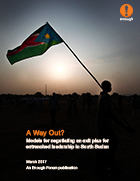
Presented by the Enough Project, the Enough Forum is a platform for dynamic discourse engaging critical issues, challenges, and questions among thought leaders, field researchers, and policy experts. Opinions and statements herein are those of the authors and participants in the forum, and do not necessarily reflect the opinion or policy recommendations of the Enough Project.
Following the July 2016 outbreak of fighting in Juba, the August 2015 Agreement on the Resolution of the Conflict in South Sudan (ARCSS) has collapsed. This conflict, which led to soldiers raping and killing civilians, saw one of the key signatories to the agreement, First Vice President Dr. Riek Machar, flee the country. The peace agreement’s collapse and subsequent fighting created new armed groups in various South Sudanese regions that had been relatively peaceful, especially in Greater Equatoria and Western Bahr el Ghazel. These armed groups’ emergence has deepened ethnic cleavages and exacerbated the conflict dynamics in the country. There is an urgency to bring an end to South Sudan’s conflict, particularly with reports warning that the country is on the “brink of genocide,” and the recent declaration of famine where 100,000 risk starvation and 1 million more are on the brink of this “man-made” famine.
Prior to the July outbreak of hostilities between the forces loyal to President Salva Kiir and now former First Vice President Machar, the relationship between the two men was fragile. The two men deeply distrust each other, which has been cited as one of the contributing factors to the genesis of the December 2013 conflict. Since the peace agreement’s collapse, it has been difficult to get both men to talk to each other. The guarantors and implementers of the peace agreement—the Intergovernmental Authority on Development (IGAD) and the Joint Monitoring and Evaluation Commission (JMEC) respectively—seem to indicate support for the status quo, i.e., that in their view the peace deal is not dead. Yet, the fact that the two key players in the August 2015 peace agreement—Kiir and Machar—cannot even agree to have a meeting suggests otherwise. However, these men are still influential in their respective camps—both holding influence and power which they are unlikely to cede easily. Yet, the loss of lives continues.
The peace deal’s death has precipitated debate on what the way out of the stalemate should be. In situations where there is a stalemate such as the one in South Sudan, there is precedence elsewhere to induce leaders to exit the scene by using certain conflict resolution measures. This research paper will review and analyze case studies of countries where measures such as the offer of asylum, amnesty, and financial leverage were employed as a means of conflict resolution. Countries such as Gambia, Liberia, Haiti, Uganda, Tunisia, and Colombia are examples where some of these offers were used to resolve conflict. It will then explore how the suggested measures, incentives, or disincentives can be applied in the case of South Sudan, as well as the strengths and the challenges surrounding their application. The research and analysis of issues such as amnesty, asylum, and financial incentives, and discussion of how they could be applicable to South Sudan should not in any way be construed as Enough’s policy toward South Sudan or an endorsement of those policy approaches.

